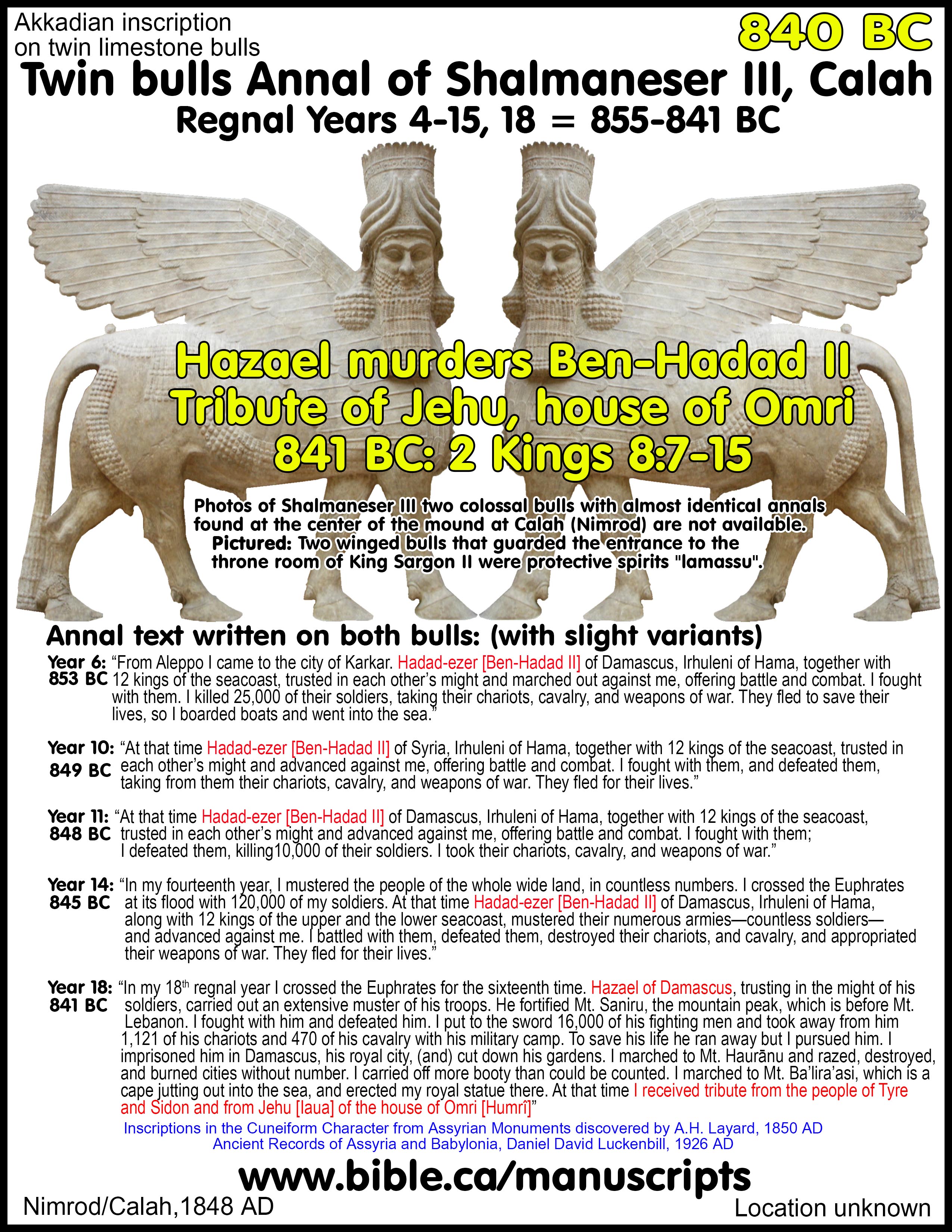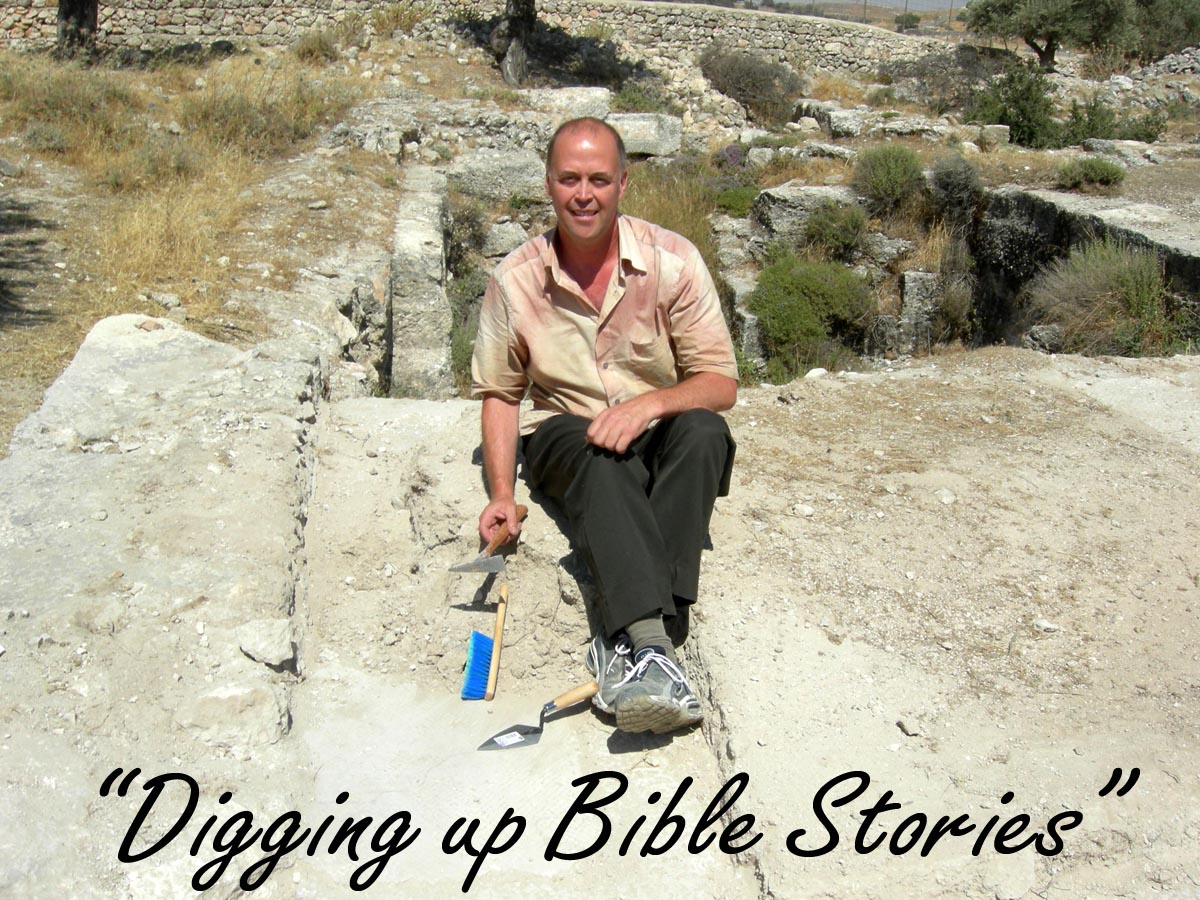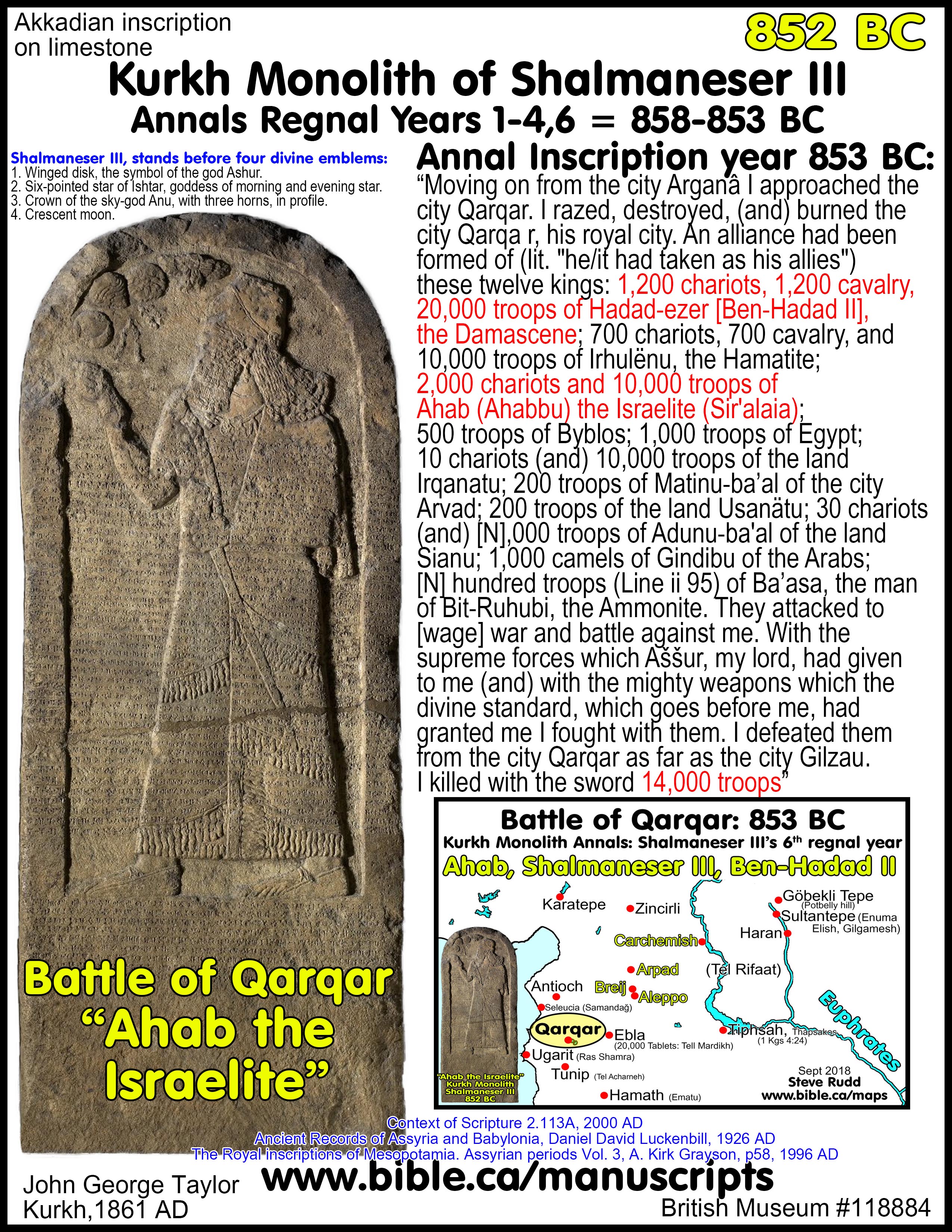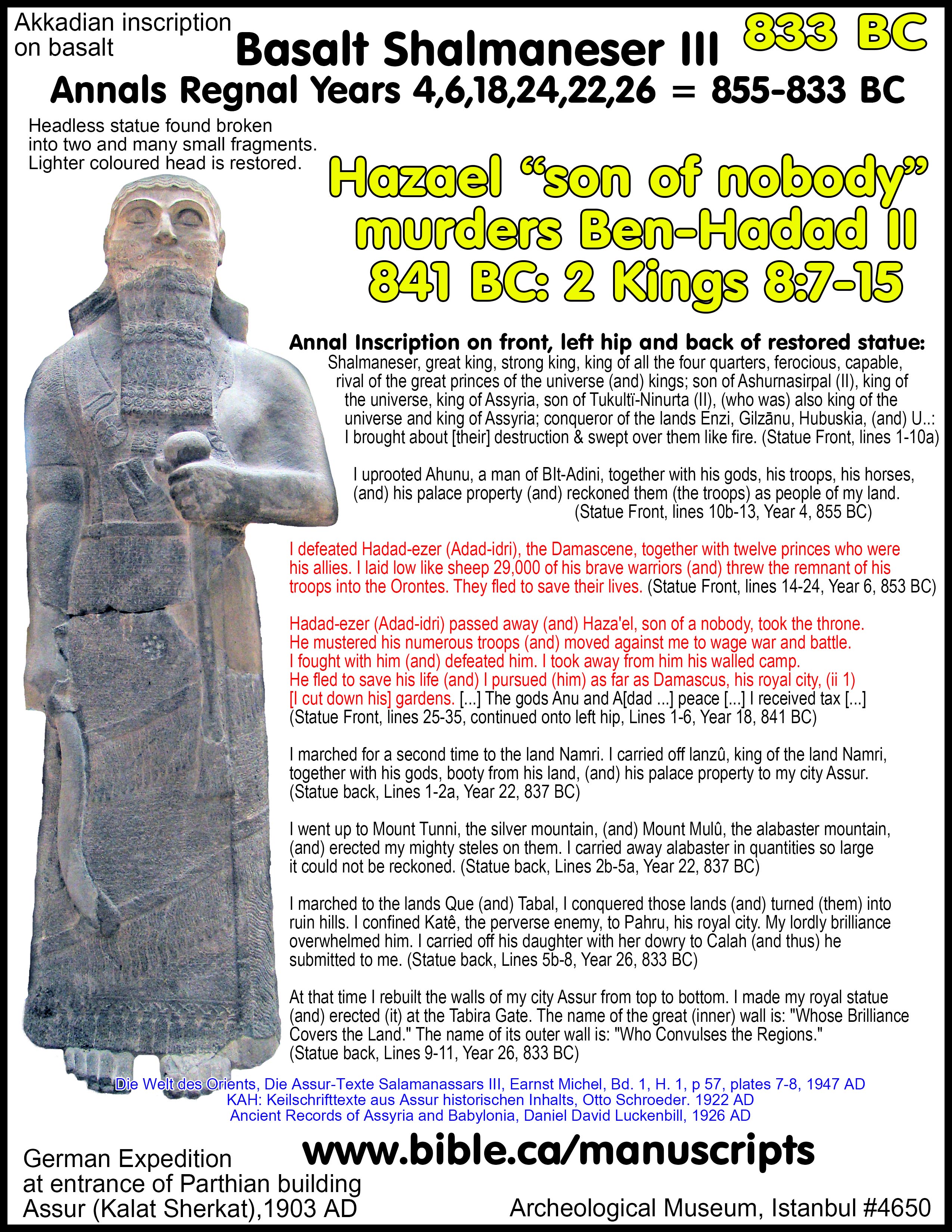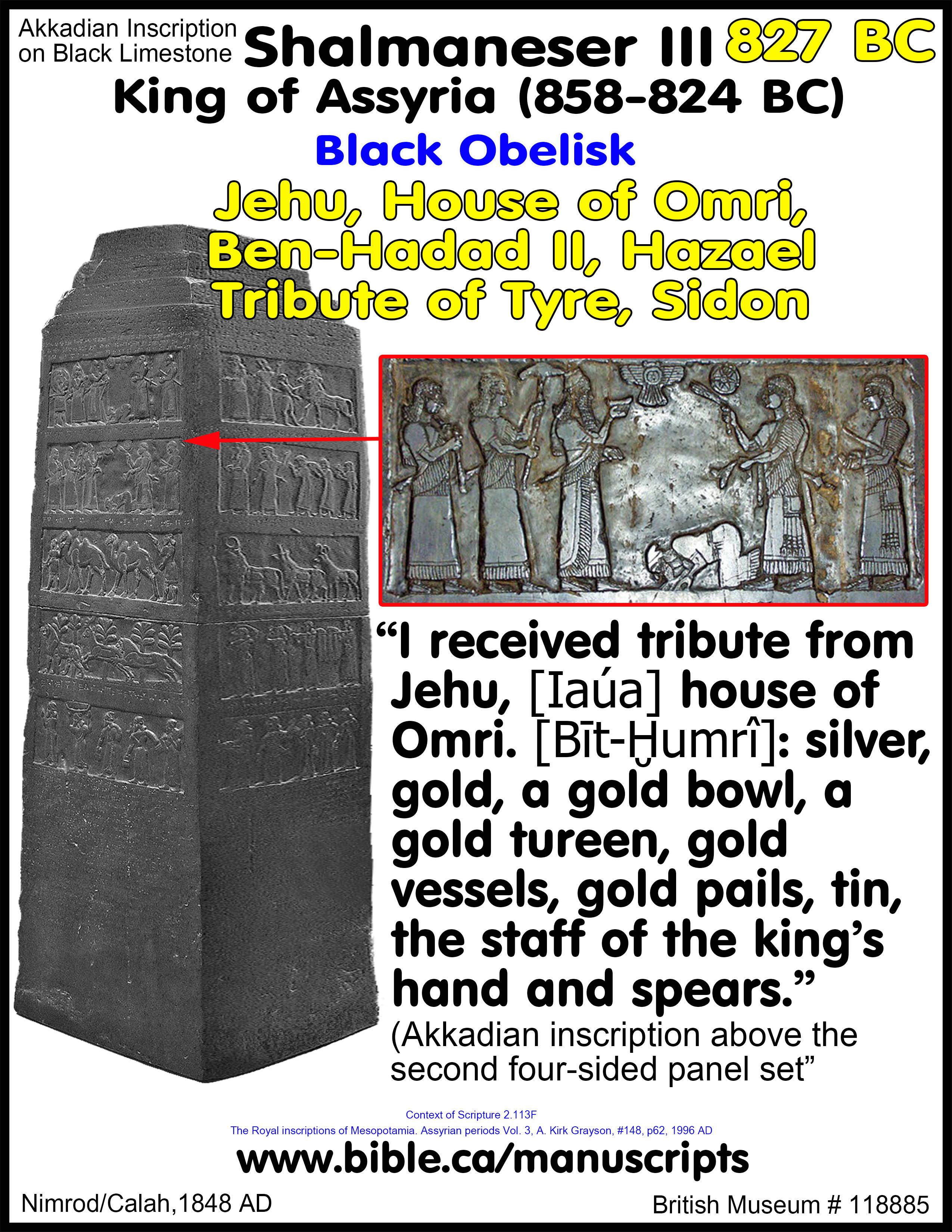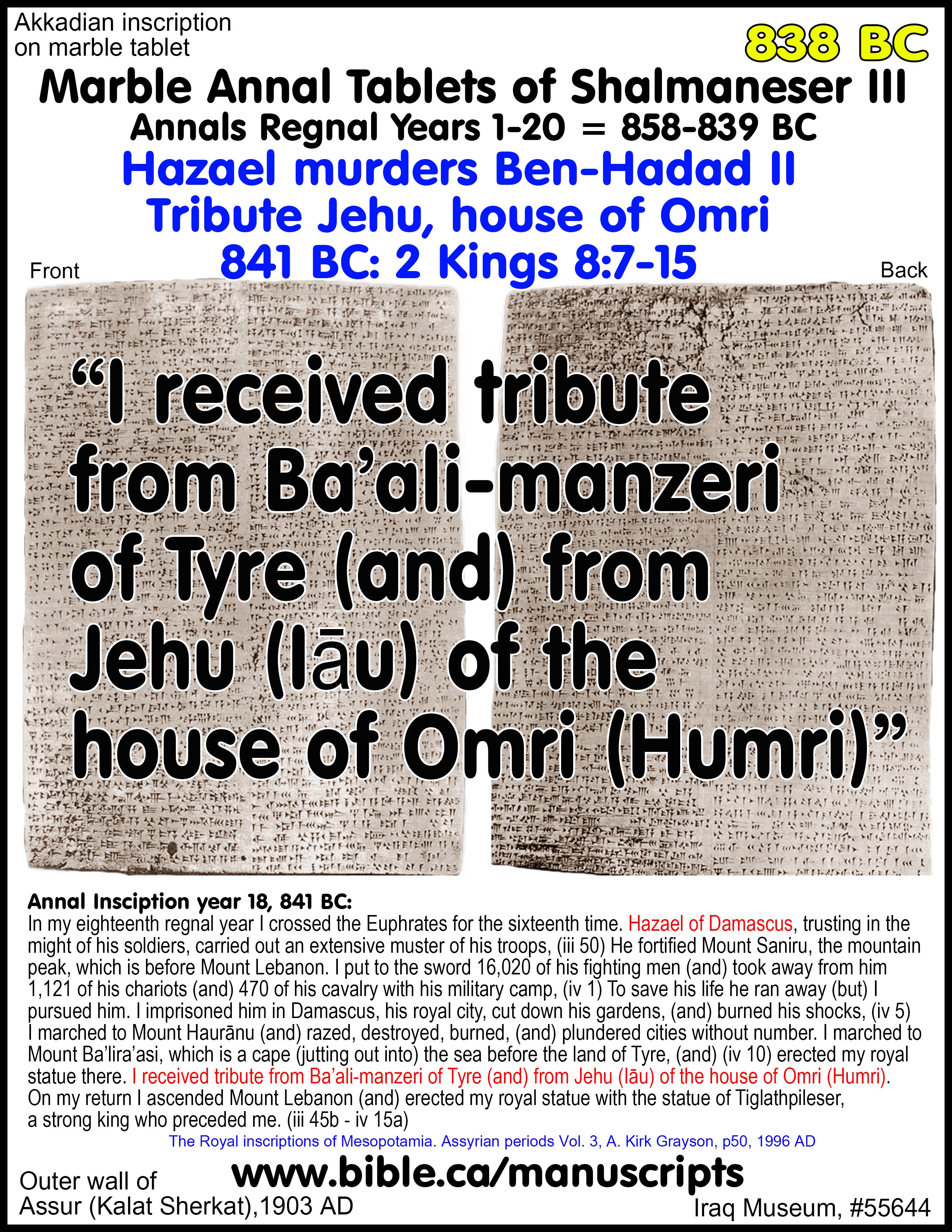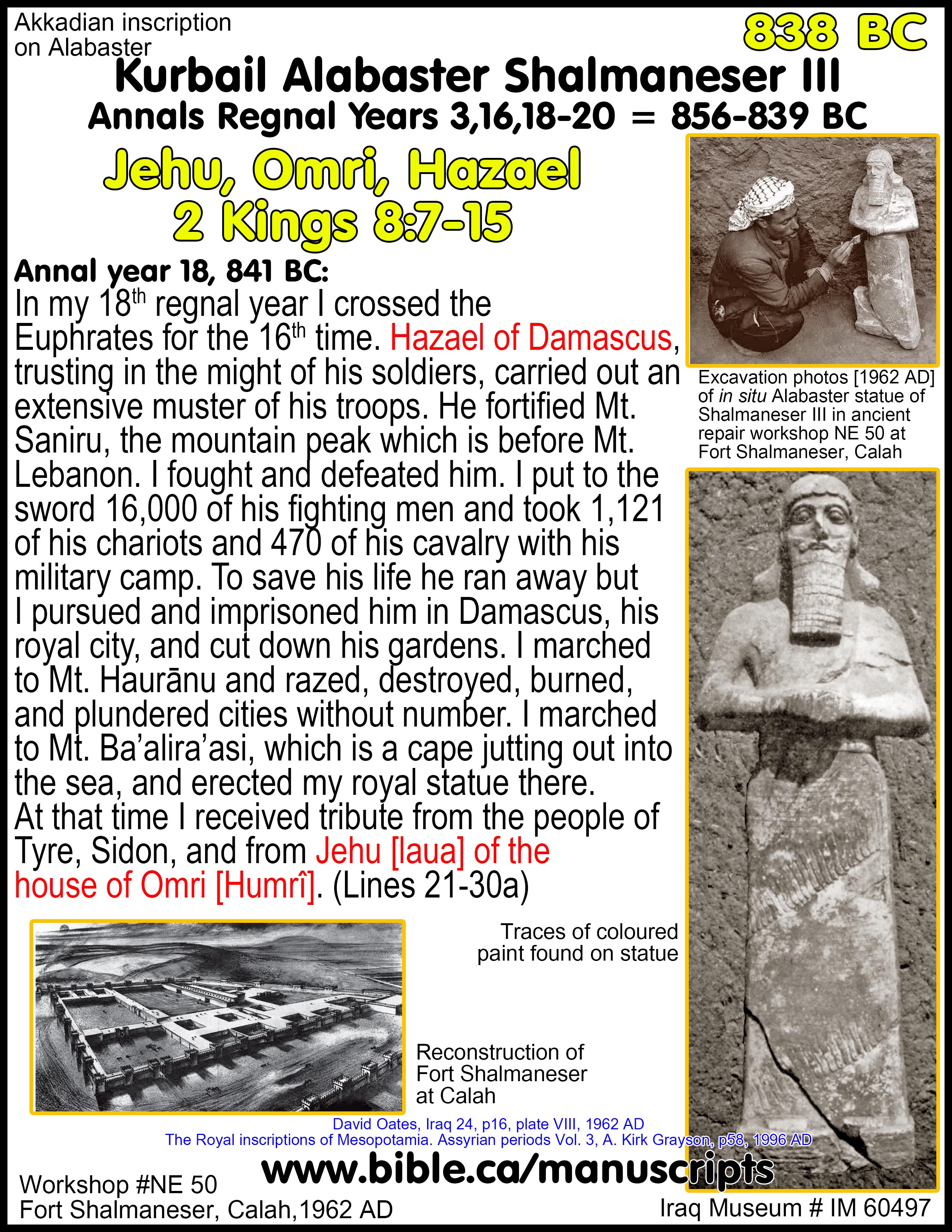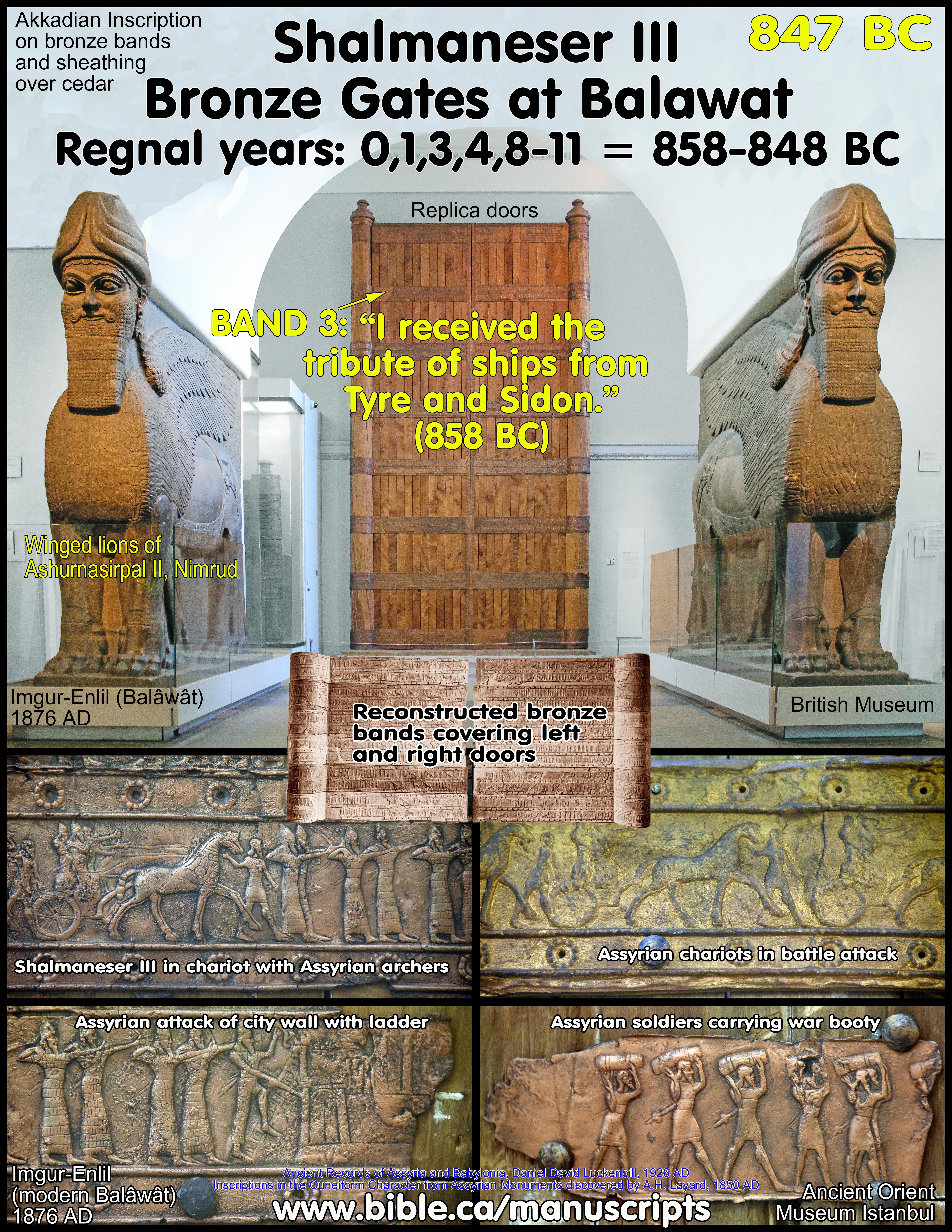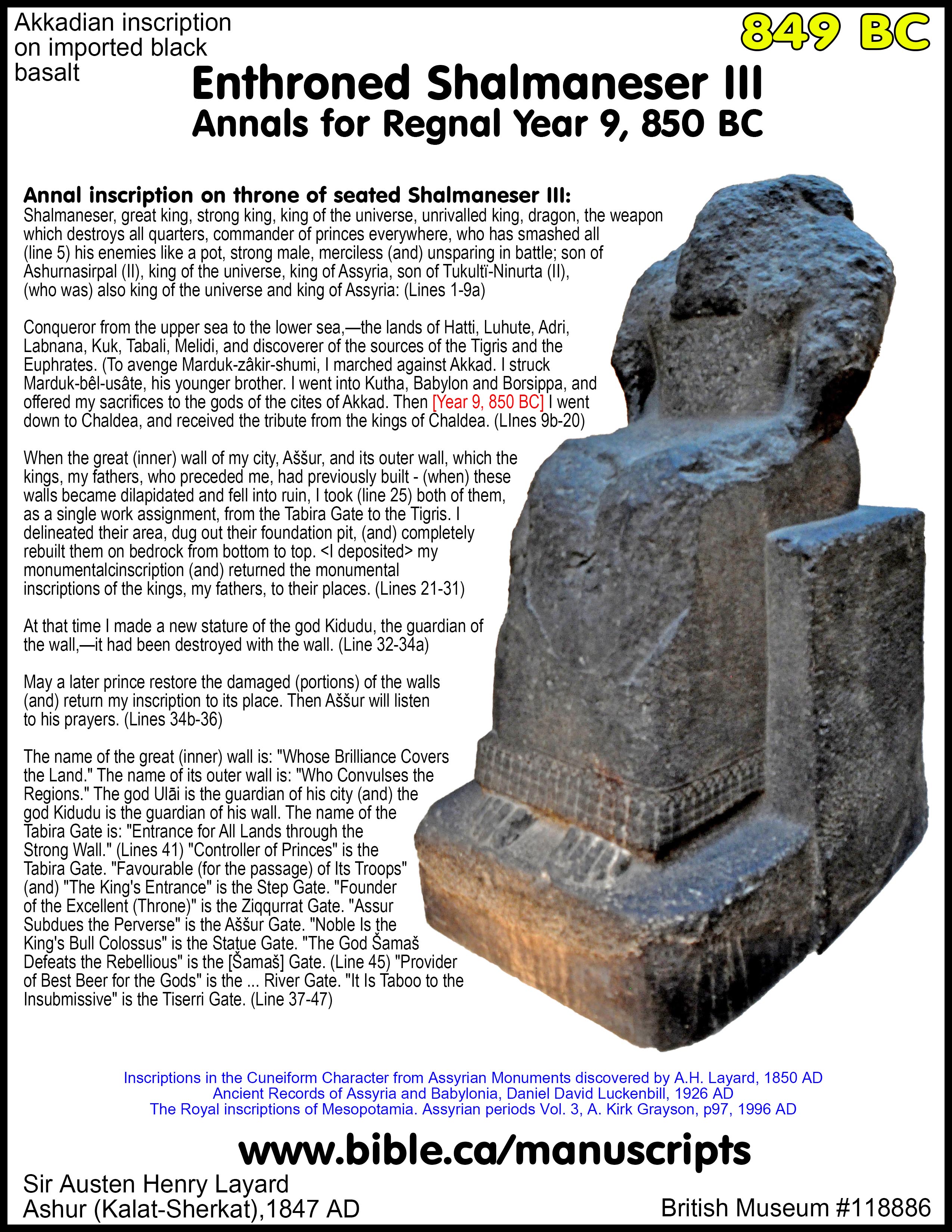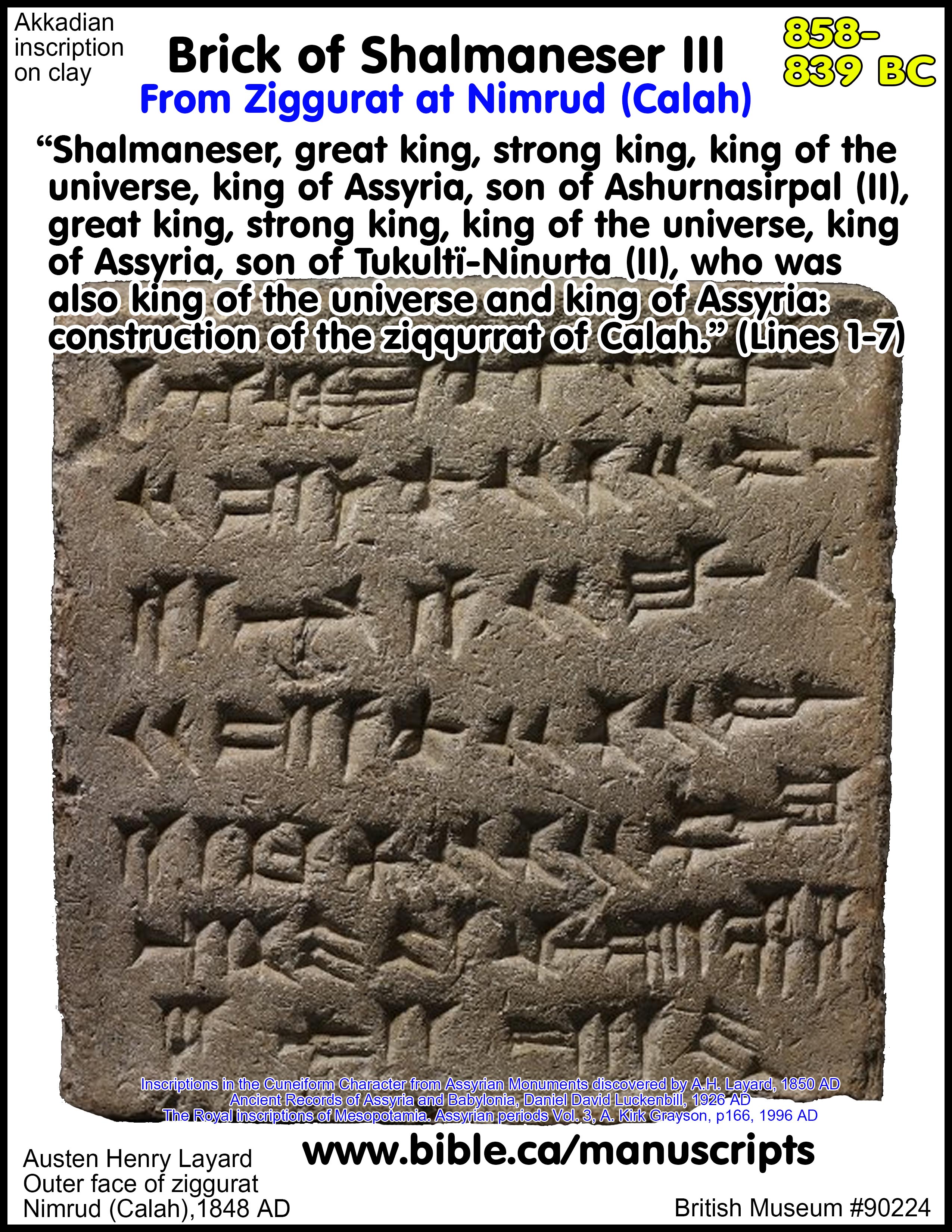Twin Monumental Bulls of Shalmaneser III: 840 BC
Shalmaneser III, King of Assyria 855-841 BC
“Jehu, House of Omri, Ben-Hadad II, Hazael, Tyre, Sidon”
See also: Detailed outline on Shalmaneser III
|
Twin Bulls of Shalmaneser III |
|
|
Date of inscription |
840 BC |
|
Annal years |
855-841 BC |
|
Glyptic object |
Akkadian Inscription on two limestone bulls |
|
Discovery |
Nimrod/Calah, 1848 AD |
|
Current location |
Unknown |
|
Bible names |
Jehu, Omri, Ben-Hadad II, Hazael, Tyre, Sidon |
|
Historic events |
Five of the six battles between Israel (Ahab, Jehoram and Jehu) and Assyria: It highlights the ongoing battles between Shalmaneser III of Assyria and the coalition of 12 kings under the command of Ben-Hadad II: 1. 853 BC, year 6. The battle of Qarqar 2. 849 BC, Year 10: Battle of Carchemish 3. 848 BC, Year 11: Battle of Hamath 4. 845 BC, Year 14: Battle of Hamath 5. 841 BC, Year 18: Siege of Damascus |
|
Digging up Bible stories! “Hazael of Damascus, trusting in the might of his soldiers, (line 5") carried out an extensive muster of his troops. He fortified Mount Saniru, the mountain peak, which is before Mount Lebanon. I fought with him (and) defeated him. (line 10") I put to the sword 16,000 of his fighting men (and) took away from him 1,121 of his chariots (and) 470 of his cavalry with his military camp. To save (line 15") his life he ran away (but) I pursued him. I imprisoned him in Damascus, his royal city, (and) cut down his gardens… At that time I received (line 25") tribute from the people of Tyre (and) Sidon (and) from Jehu (Iaua) of the house of Omri (Humrî).” (Lines I"-27")
“What we read in the book, we find in the ground” |
Introduction:
1. Importance of the Twin Bulls for Bible students:
a. Most important is the famous reference to King Jehu of the house of king Omri, Ben-Hadad II, Hazael
b. The cities of Sidon and Tyre are listed as giving tribute.
2. Hazael trapped inside Damascus by Shalmaneser III:
a. After meeting with Elisha in 2 kings 8 and being told he will be the new king who will defeat Israel, Hazael decides to attack Syria!
b. The Bible tells us that Hazael killed King Ben-Hadad II.
c. We learn that Hazael took offensive military maneuvers against Assyria and Shalmaneser III counter-attacked Hazael and penned him up inside Damascus in a siege.
d. “Hazael of Damascus, trusting in the might of his soldiers, (line 5") carried out an extensive muster of his troops. He fortified Mount Saniru, the mountain peak, which is before Mount Lebanon. I fought with him (and) defeated him. (line 10") I put to the sword 16,000 of his fighting men (and) took away from him 1,121 of his chariots (and) 470 of his cavalry with his military camp. To save (line 15") his life he ran away (but) I pursued him. I imprisoned him in Damascus, his royal city, (and) cut down his gardens.” (Lines I"-27")
e. This is the only inscription that specifically says that Hazael was trapped in Damascus as Shalmaneser III attacked it with a siege.
f. This echoes the later Sennacherib annals prism inscription of 689 BC that says, “Hezekiah, I made a prisoner in Jerusalem, his royal residence, like a bird in a cage.” This confirms the story in 2 Kings 18:13.
g. The arrogant confidence of Hazael after meeting Elisha was misplaced.
3. Submit to the pagan god Assur or die:
a. “I put to the sword (the inhabitants of) cities insubmissive to Aššur (and) received tribute from the land Nairi.” (Twin colossal bulls, Shalmanser III, Lines 20'-23'a, 852 BC, Regnal year 7)
b. It is unclear if “submission” meant they worshipped another pagan god other than Assur, or if they simply would not submit to Shalmaneser III.
c. The Law of Moses instructed idol worshippers to be stoned. However, Jews never attacked cities outside their own land.
d. Islam is a blend of the outward-looking evangelism of Christianity and the “death to infidels” of both Jews and Shalmaneser III.
e. Today, Muslims want to bring the entire world into submission to their pagan god. Originally Allah of Muslims today, was the Arabian moon god Hubal, on the roof of the Kabbah at Mecca at the time Muhammed was born. Today, the black meteorite embedded in the corner of the Kabbah is kissed by worshippers and used for counting the 7 revolutions around the Kabbah, one for each of 7 planets known in the 7th century AD.
4. Five of the Six battles with Israel:
a.
853 BC, year 6. The battle of
Qarqar where Shalmaneser III warred
against Ben-Hadad II and his coalition of 12 kings, one of whom was Ahab: “Moving on from Aleppo (Halman) I approached the city Qarqar.
Hadad-ezer (Adad-idri) [Ben-Hadad II], the Damascene, Irhulënu, the Hamatite,
together with twelve kings on the shore of the sea, trusting in their united
forces, attacked me to wage war and battle. I fought with them. I put to the
sword 25,000 of their fighting men (and) captured from them their chariotry,
cavalry, (and) military equipment. To save their lives they ran away. I boarded
boats (and) went out upon the sea.” (Lines 12'b-19')
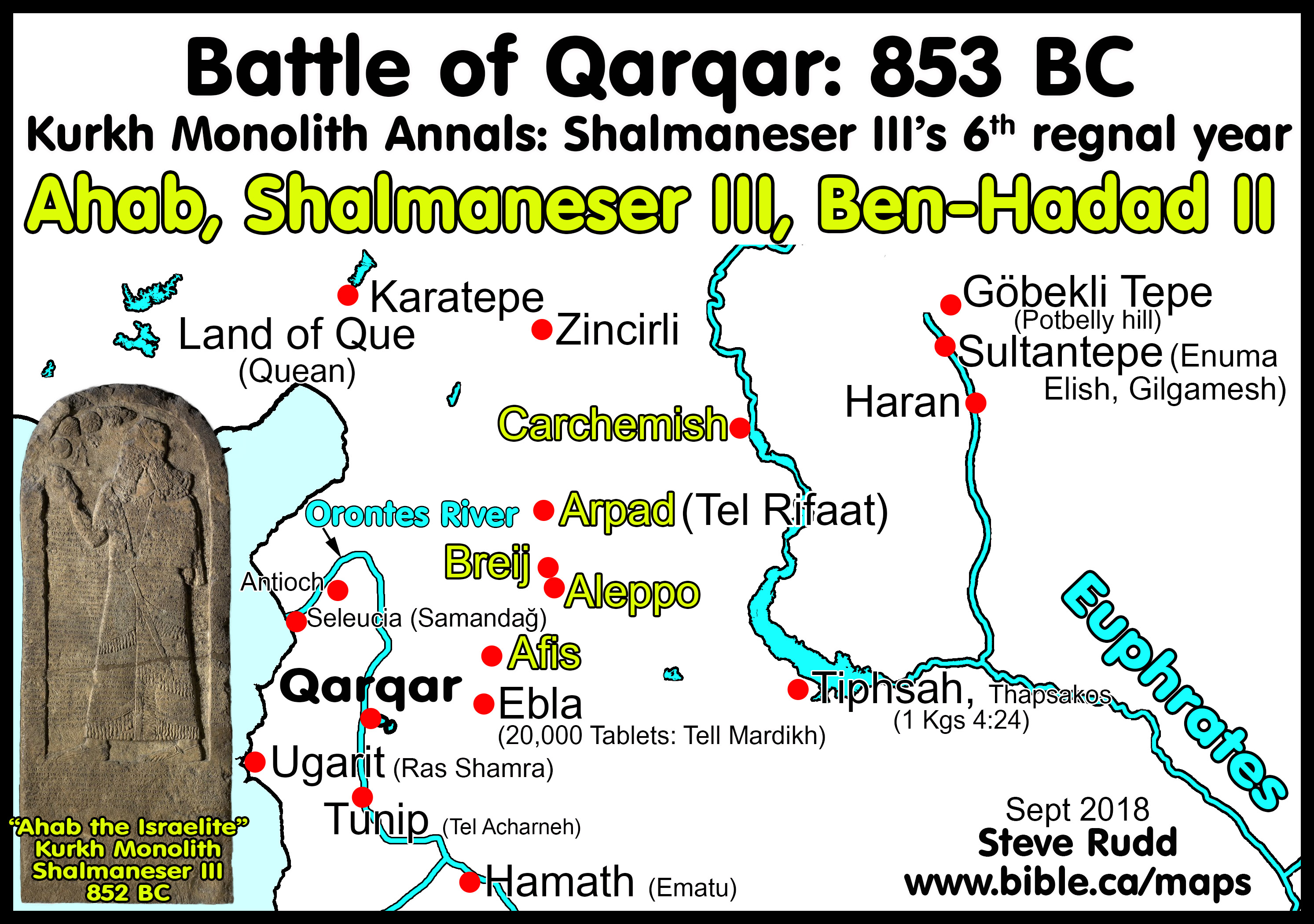
b. 849 BC, Year 10: Battle of Carchemish with Ben-Hadad II and 12 kings, one of whom was Jehoram, king of Israel: [Note: Battle at Carchemish, then War with 12 kings Aram, Samaria] “At that time, Hadad-ezer (Adad-idri), the Damascene, (and) Irhulenu, the Hamatite, together with twelve kings on the shore of the sea, trusting in their united forces, attacked me to wage war and battle. I fought with them (and) defeated them. I took from them their chariotry, cavalry, and military equipment. To save their lives they ran away.” (Lines 29'b-34')
c. 848 BC, Year 11: Battle of Hamath: War with Ben-Hadad II and 12 kings, one of whom was Jehoram, king of Israel: “At that time Hadad-ezer (Adad-idri), the Damascene, (and) Irhulënu, the Hamatite, together with twelve kings on the shore of the sea, trusting in their united forces, attacked me to wage war and battle. I fought with them (and) defeated them. I put to the sword 10,000 of their fighting men. I took from them their chariotry, cavalry, and military equipment.” (Lines 35'-41'a)
d. 845 BC, Year 14: Battle of Hamath: War with Ben-Hadad II and 12 kings of Aram, Samaria, one of whom was Jehoram, king of Israel: “At that time Hadad-ezer (Adad-idri), the Damascene, (and) Irhulënu, the Hamatite, together with twelve kings on the shore of the sea, above and below, mustered their troops which were too numerous to be counted. They attacked me, I fought with them, (and) defeated them. I destroyed their chariotry (and) cavalry — (and) took away their military equipment. To save their lives they ran away.” (Lines 44b-47a)
e. 845 BC, Year 14: The Melqart Stele was erected by Ben-Hadad II in preparation for this battle.
i. The stele was erected as a kind of “rabbit’s foot” lucky charm to invoke the assistance of the pagan god named “Melqart”.
ii. Of course, Shalmaneser was also invoking the assistance of his own pagan god’s names “Assur”.
iii. See also full outline on Melqart
Stele
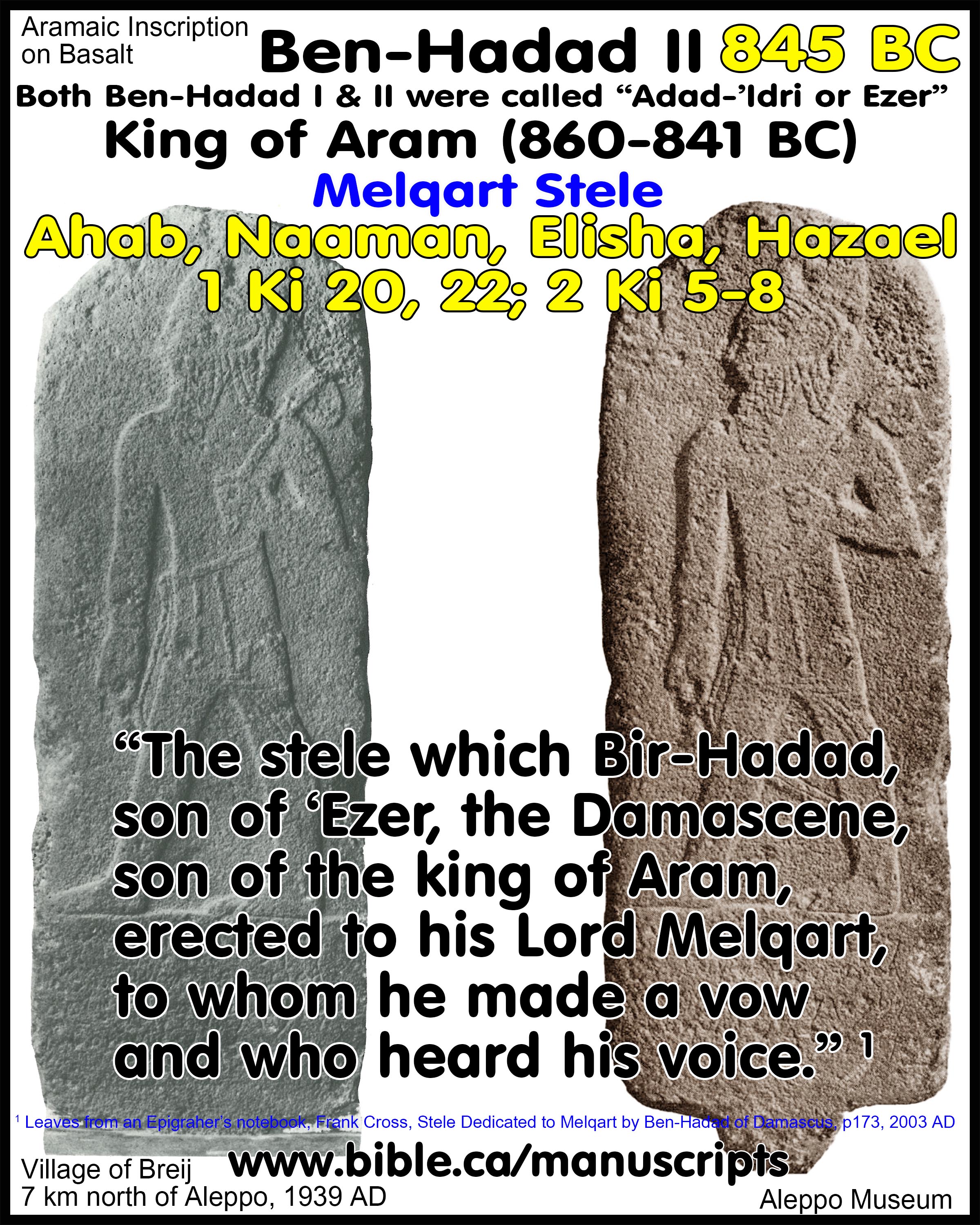
f. 841 BC, Year 18: Siege of Damascus: against Hazael: “Hazael of Damascus, trusting in the might of his soldiers, (line 5") carried out an extensive muster of his troops. He fortified Mount Saniru, the mountain peak, which is before Mount Lebanon. I fought with him (and) defeated him. (line 10") I put to the sword 16,000 of his fighting men (and) took away from him 1,121 of his chariots (and) 470 of his cavalry with his military camp. To save (line 15") his life he ran away (but) I pursued him. I imprisoned him in Damascus, his royal city, (and) cut down his gardens. I marched to Mount Haurānu (and) razed, destroyed, (and) (line 20") burned cities without number. I carried off more booty than could be counted. I marched to Mount Ba’lira’asi, which is a cape (jutting out into) the sea, (and) erected my royal statue there. At that time I received (line 25") tribute from the people of Tyre (and) Sidon (and) from Jehu (Iaua) of the house of Omri (Humrî).” (Lines I"-27")
5. The text of the twin monumental bulls (Twin Bulls) and clay tablet #54669 (see Marble and clay Tablets) are almost identical
6. Sources:
a. Inscriptions in the Cuneiform Character from Assyrian Monuments discovered by A.H. Layard, 1850 AD
b. Ancient Records of Assyria and Babylonia, Daniel David Luckenbill, 1926 AD
7. See Detailed outline on Shalmaneser III
I. About the Twin Bulls:
1. Shalmaneser III commission the creation of two very large statues of bulls:
a. The two bulls were basically identical except for what you would expect with one facing left and the other right.
b. Each bull had and almost identical inscription.
c. There are minor, insignificant differences in the inscriptions on each bull that are likely due to scribal variants.
2. “On two large bull-colossi, from the center of the mound at Nimrűd, we have slightly varying copies of a version of Shalmaneser’s annals which ended with the eighteenth year (text published in Layard, Inscriptions, Plates 12 f. and 46 f.), See also Delitzsch, BA, VI, 144 f., whose numbering of the lines is here followed.” (Ancient Records of Assyria and Babylonia, Daniel David Luckenbill, 1926 AD)
3. “This version of the annals is reconstructed from inscriptions on two monumental bulls from Calah, supplemented by two small fragments of inscribed stone, which probably came from the same site. The text begins with Shalmaneser MFs name, titles, epithets, genealogy, and a 'general description of his conquests (lines 1-40). After a lacuna in which the early campaigns were described, a narrative of the third to fifteenth regnal years is given (lines l'-51'). After another lacuna the text has a description of activities in the eighteenth regnal year (lines 1 "—27"). Then the text either ends or is broken. If it ended here, that meant it was written in or after 841 BC.” (The Royal inscriptions of Mesopotamia. Assyrian periods Vol. 3, A. Kirk Grayson, p42, 1996 AD)
4. “Commentary: In general the master text is ex. 1 but with restorations from exs. 2 and 3. It is by no means certain that all the inscriptions edited together here are exs. of the same text. The uncertainty is compounded by the fact that exs. 1 3 are known only from publications based on squeezes in the British Museum which were subsequently destroyed (see Gaiter, et al., ARR1M 4 [1986] p. 27). Exs. 1 and 2 were inscriptions on two colossal bulls while the nature of the stone object upon which ex. 3 was inscribed is unknown. Ex. 4 is on a small stone fragment. The problem of identifying these various inscriptions with one text requires comment. Ex. 4 is the easiest since it only has a few lines which are clearly duplicates of lines 46'-48' in this edition. Exs. 1 and 2 (Layard's "Bulls 1 and 2") each have some lines not found on the other, according to Layard (cf. Grayson, BiOr 33 [1976] p. 145 n. 92). Ex. 1 omits lines 50'b-51' and ex. 2 omits lines 39'b-45'a. An analogous situation is attested for the inscribed bulls and lions of Asn. II, A.0.101.2 (RIMA 2 pp. 223-28), and in the edition of that text there was reason to believe that the missing passages were inscribed on adjacent objects which were not recovered. With exs. 1 and 2 of the present text, however, there is a further complication. The narrative of the eighteenth regnal year was copied by Layard as following the introduction and preceding the narrative of the earlier years (ICC pi. 13 lines 12-19 and "Bull 2" = lines 1 -13" of this edition). These factors suggest that the bulls were inscribed on various parts of the body, as was done with colossal animals from other reigns. The sequence of the different sections can only be established from the content. When Layard prepared and published ICC (1851), knowledge of cuneiform was, with all due respect to Layard and his contemporaries, still primitive and the understanding of the content superficial. Thus it was difficult to decide in what order to copy and publish the various inscribed passages. In conclusion, I believe it best to follow Layard's lead in regarding the inscriptions on Bulls 1 and 2 as exs. of one text. But, when necessary, the passages must be rearranged to follow a chronological sequence, which means placing the narrative of the eighteenth year at the end of the text. This is what Delitzsch did. Ex. 3 has only the narrative of the eighteenth year and, after duplicating the relevant passage in Bull 2 (lines 1"-13" in this edition), it goes on with further details (lines 14"-27"). The squeeze from which ex. 3 comes cannot be of Bull 2, both because of these additional lines and because the line division on the two exs. is different where they duplicate one another. Thus, I have regarded all four inscriptions as exs. of a single text and put that text together according to chronological sequence, generally following Delitzschs edition. I have numbered the lines in sequence, allowing for a lacuna after line 40, and another after line 51'. It is unknown if there is a lacuna after line 27" or if the text simply ended here. The lacuna between lines 40 and Y must have been large since the regnal years up to year 4 are omitted. Similarly, the lacuna between lines 51' and V was large since the regnal years 16 and 17 are omitted. For convenience here is a chart of line equivalents in various publications: [omitted] As to the exactness of what is preserved on each ex., there is a problem with exs. 1 and 2. In ICC Layard implies that the two are duplicates of each other, with some variation. But he does not publish a complete copy of the full inscription on ex. 2; he only copies the equivalent of lines 12'-51' and 9'-13". Thus, in the scores I have put "—" for the remainder, except for lines 14"-27", for which we only have ex. 3. It is unknown if exs. 3 and 4 once had the full text, since they arc only small fragments, but I have put "[...J" in the scores for the missing lines. The description of the campaigns for the third to the fifteenth regnal years is a duplicate of the narrative in A.0.102.6: lines 1 - 5 1 ' // A.0.102.6 i 64 - iii 45. This is of great help in reconstructing and restoring the badly preserved early portions: lines 1 '—15' // A.0.102.6 i 64 - ii 26.” (The Royal inscriptions of Mesopotamia. Assyrian periods Vol. 3, A. Kirk Grayson, p42, 1996 AD)
II. Translation of the Twin Bulls
|
Date Regnal Year Nisan |
Translated Text Note: The text of the twin monumental bulls (Twin Bulls) and clay tablet #54669 (see Marble and clay Tablets) are almost identical |
|
Jan 858 BC Year 0 intro |
Shalmaneser, king of all people, prince, viceregent of Aššur, strong king, king of all (5) the four quarters, sun(god) of all people, ruler of all lands, king, desired object of the gods, chosen of the god Enlil, (10) trustworthy appointee of Aššur, attentive prince, who has seen remote and rugged regions, who has trodden upon the mountain peaks in all the highlands, receiver of booty (and) tax from all the (four) quarters, who opens paths above and below, at whose strong attack for combat (line 15) the (four) quarters are distressed (and) cities convulsed, strong male who acts with the support of Aššur (and) the god Šamaš, the gods his allies, and has no rival among the princes of the four quarters, magnificent king of lands, who has kept progressing by difficult ways through mountains and seas; (Lines 1-19) Son of Ashurnasirpal (II), exalted prince, whose priesthood was pleasing to the gods and (who) subdued all lands at his feet, pure offspring of Tukulti-Ninurta (II), who slew all his enemies and annihilated (them) like a flood; (Lines 20-24a) conqueror from the upper [Lake Van] and lower seas to the land Nairi and the great sea of the west as far as the Amanus range: I gained dominion over the entire land Hatti. I conquered from the source of the Tigris to the source of the Euphrates. I annihilated like a flood from the land Enzi to the land Suhni, from the land Sulini (line 30) to the land Melid, from the land Melid to the land Daiēnu, from the land Daiēnu to the land Arsaskun, (line 35) from the land Arsaskun to the land Gilzānu. from the land Gilzānu to the city Hubuskia, <from> the land Namri to the sea of Chaldaea [Persian Gulf], which is called the Marratu ("Bitter") River. (24b-40) |
|
856 BC Year 3 |
Lacuna [In my third regnal year ... to the city Arsaskun], the royal city of A[ramu the Urartian. Aramu trusted in the strength of his army and] mustered [his numerous cavalry to wage war and battle against me. I defeated him (and) deprived him of his cavalry (and) military equipment. To save his life he climbed] up a [rugged] mountain. [They (his people) became frightened] in the face of my mighty [weapons, abandoned their cities, and took to a rugged mountain]. I captured [the city Arsaskun], his royal [city], together with the cities in its environs. [I brought out his incalculable possessions and property (and) razed, destroyed, (and) burned the(se) cities. I annihilated like a flood] from the land Gilzänu to the city Uubuskia. [From the pass of Mount Kirruru I] emerged [before the city Arbail]. (Lines 1 ' - 5 ' a ) |
|
855 BC Year 4 |
In my fourth regnal year, [on the thirteenth day of the month lyyar, I moved out from Nineveh (and) crossed the Euphrates in flood] in pursuit [of Ahunu, the man of Bit-Adini. He had made as his stronghold] Mount Šītamrat, a mountain peak [on the bank of the Euphrates which is suspended from heaven like a cloud]. I besieged (and) captured the mountain peak. [Ahunu, together with his gods, his chariots, his horses, (and) 22,000 of his troops I uprooted (and) brought to my city Aššur]. (Lines 5'b-8'a)
[In this same year I moved out from Inner] City (Assur), [crossed] Mount Kullar, [went down to the interior of the land Zamua, (and)] captured [the cities of Nikdęra, the Id]ean. The remnant of (line 10') their army [boarded boats of papyrus and escaped by sea. I boarded boats of inflated skins (and)] pursued them. [I defeated] them in the midst of [the sea (and) plundered them]. (Lines 8'b-11’a) |
|
854 BC Year 5 |
[In my fifth regnal year I moved out from Nineveh] and ascended Mount Kašiiari. I captured eleven fortified cities (and) [confined Anhitti, the Šubraean, to his city] (and) received [his tribute]. (Lines 11'b-12'a) |
|
853 BC Year 6 Battle of Qarqar with Ben-Hadad II and 12 kings. Eponymy of Daiiān-Aššur
|
In my sixth regnal year I moved out from Nineveh and approached the cities on the banks of the River Balih. They became frightened in the face of my mighty weapons and [killed] Giammu, [their city] ruler. I entered the city Til-turahi (and) claimed the city as my own. Moving on from the banks of the River Balih [I crossed the Euphrates in flood]. (line 15') I received [tribute] from the kings of the land Hatti. Moving on from the land Hatti I approached Aleppo (Halman) (and) made sacrifices [before the god Adad] of Aleppo (Halman). Moving on from Aleppo (Halman) I approached the city Qarqar. Hadad-ezer (Adad-idri) [Ben-Hadad II], the Damascene, Irhulënu, the Hamatite, together with twelve kings on the shore of the sea, trusting in their united forces, attacked me to wage war and battle. I fought with them. I put to the sword 25,000 of their fighting men (and) captured from them their chariotry, cavalry, (and) military equipment. To save their lives they ran away. I boarded boats (and) went out upon the sea. (Lines 12'b-19') |
|
852 BC Year 7 |
In my seventh regnal year I marched to the cities of Hahinu, the Til-abnīan. I captured (and) burned Til-abnď, his fortified city, together with the cities in its environs. Moving on from Til-abnī I marched to the source of the Tigris, the place where the water comes out, (and) made sacrifices. I put to the sword (the inhabitants of) cities insubmissive to Aššur (and) received tribute from the land Nairi. (Lines 20'-23'a) |
|
851 BC Year 8 |
In my eighth regnal year, at the time of Marduk-zäkir-sumi (I), king of Kardunias, Mardukbēl- usāte, his brother, rebelled against him. I marched out for vengeance (and) captured the cities Męturnat and Lahiru. (Lines 23'b-24'a) |
|
850 BC Year 9 |
In my ninth regnal year, in my second campaign (to Babylonia), I captured the city Gannanāte. To save his life Marduk-bel-usāte went up to the city Halman. I pursued him (and) put to the sword Marduk-bę1-usāte together with the treacherous soldiers who were with him. (Then) I marched to Babylon (and) made sacrifices in Babylon, Borsippa, (and) Cuthah. I went down to Chaldaea (and) captured their cities. I marched to the sea which is called the Marratu ("Bitter") River (and) received tribute in Babylon from Adinu, the man of Bīt-Dakkuri, (and) from Musallim-Marduk, the man of Bīt-Amukkāni (Ukānu): silver, gold, ebony, (and) elephant ivory. (Lines 24'b-29'a) |
|
849 BC Year 10 Battle of Carchemish with Ben-Hadad II and 12 kings |
In my tenth regnal year I crossed the Euphrates for the eighth time. I razed, destroyed, (and) burned the cities of Sangara, the Carchemishite. Moving on from the cities of the Carchemishite I approached the cities of Aramu (and) captured the city Arnę, his royal city. I razed, destroyed, (and) burned (it) together with one hundred cities in its environs. I massacred them (and) plundered them. At that time, Hadad-ezer (Adad-idri), the Damascene, (and) Irhulenu, the Hamatite, together with twelve kings on the shore of the sea, trusting in their united forces, attacked me to wage war and battle. I fought with them (and) defeated them. I took from them their chariotry, cavalry, and military equipment. To save their lives they ran away. (Lines 29'b-34') |
|
848 BC Year 11 War with Ben-Hadad II and 12 kings |
In my eleventh regnal year I moved out from Nineveh (and) crossed the Euphrates in flood for the ninth time. I captured ninety-seven cities of Sangara. I captured, razed, destroyed, (and) burned one hundred cities of Aramu. I took to the slopes of the Amanus range, crossed Mount laraqu, (and) descended to the cities of the people of Hamat. I captured the city Aštammaku, together with ninetynine (other) cities. I massacred their (inhabitants) (and) plundered them. At that time Hadad-ezer (Adad-idri), the Damascene, (and) Irhulënu, the Hamatite, together with twelve kings on the shore of the sea, trusting in their united forces, attacked me to wage war and battle. I fought with them (and) defeated them. I put to the sword 10,000 of their fighting men. I took from them their chariotry, cavalry, and military equipment. On my return I captured Aparāzu, the fortified city of Aramu. At that time I received tribute from Qalparunda the Patinean: silver, gold, tin, horses, oxen, sheep, (and) linen garments. I went (back) up the Amanus range (and) cut beams of cedar. (Lines 35'-41'a) |
|
847 BC Year 12 |
In my twelfth regnal year I moved out from Nineveh (and) crossed the Euphrates for the tenth time. I marched to the land Paqarahubunu, (where) the people became frightened (and) took to a rugged mountain. I besieged (and) captured the mountain peak. I massacred them (and) brought plunder and possessions of theirs down from the mountain. (Lines 41'b-43'a) |
|
846 BC Year 13
|
In my thirteenth regnal year I entered the Pass of the Goddesses, marched to Matiātu, (and) captured all of Matiātu. I slaughtered their (inhabitants) (and) took countless plunder from them. (Lines 43'b-44'a) |
|
845 BC Year 14 Melqart Stele. War with Ben-Hadad II and 12 kings Aram, Samaria |
In my fourteenth regnal year I mustered (the troops of my) extensive land in countless numbers (and) crossed the Euphrates in flood with 120,000 troops. At that time Hadad-ezer (Adad-idri), the Damascene, (and) Irhulënu, the Hamatite, together with twelve kings on the shore of the sea, above and below, mustered their troops which were too numerous to be counted. They attacked me, I fought with them, (and) defeated them. I destroyed their chariotry (and) cavalry — (and) took away their military equipment. To save their lives they ran away. (Lines 44b-47a) |
|
844 BC Year 15 |
In my fifteenth regnal year I marched to the land Nairi. I created at the source of the Tigris, on a mountain cliff where its water comes out, my royal statue. I wrote thereon praises of my power (and) my heroic deeds. (Then) I entered the pass of Mount Tunibunu (and) razed, destroyed, (and) burned the cities of Aramu, the Urartian, as far as the source of the Euphrates. (Thus) I marched to the source of the Euphrates, made sacrifices to my gods, (and) washed the weapons of Aššur therein. Asia, king of the land Daiēnu, submitted to me (and) I received from him tax and tribute of horses. I fashioned my royal statue (and) erected (it) inside his city. (Lines 47'b-51) |
|
841 BC Year 18 War with Hazael |
Lacuna In my eighteenth regnal year I crossed the Euphrates for the sixteenth time. Hazael of Damascus, trusting in the might of his soldiers, (line 5") carried out an extensive muster of his troops. He fortified Mount Saniru, the mountain peak, which is before Mount Lebanon. I fought with him (and) defeated him. (line 10") I put to the sword 16,000 of his fighting men (and) took away from him 1,121 of his chariots (and) 470 of his cavalry with his military camp. To save (line 15") his life he ran away (but) I pursued him. I imprisoned him in Damascus, his royal city, (and) cut down his gardens. I marched to Mount Haurānu (and) razed, destroyed, (and) (line 20") burned cities without number. I carried off more booty than could be counted. I marched to Mount Ba’lira’asi, which is a cape (jutting out into) the sea, (and) erected my royal statue there. At that time I received (line 25") tribute from the people of Tyre (and) Sidon (and) from Jehu (Iaua) of the house of Omri (Humrî). (Lines I"-27") |
Conclusion:
1. The Twin Bulls of Shalmaneser III is a stunning confirmation of the historical accuracy of the Bible:
a. It names Jehu, Omri, Ben-Hadad II and Hazael
b. It names the cities of Tyre and Sidon
2. We learn new information that happened in 841 BC:
a. After meeting with Elisha in 2 kings 8 and being told he will be the new king who will defeat Israel, Hazael decides to attack Syria!
b. The Bible tells us that Hazael killed King Ben-Hadad II.
c. We learn that Hazael took offensive military maneuvers against Assyria and Shalmaneser III counter-attacked Hazael and penned him up inside Damascus in a siege.
d. The arrogant confidence of Hazael after meeting Elisha was misplaced.
3. Five of six battles between Israel and Assyria: It highlights the ongoing battles between Shalmaneser III of Assyria and the coalition of 12 kings under the command of Ben-Hadad II of Aram (Damascus) which included three Israeli kings: Ahab, Jehoram and Jehu.
a. 853 BC, year 6. The battle of Qarqar
b. 849 BC, Year 10: Battle of Carchemish
c. 848 BC, Year 11: Battle of Hamath
d. 845 BC, Year 14: Battle of Hamath
e. 841 BC, Year 18: Siege of Damascus
4. 845 BC, Year 14: The Melqart Stele was erected by Ben-Hadad II in preparation for this battle.
5. What you read in the book, you find in the ground! Find me a church to attend in my home town this Sunday!
|
9 Inscriptions of Shalmaneser III |
||
|
|
|
|
|
|
|
|
By Steve Rudd: Contact the author for comments, input or corrections.
